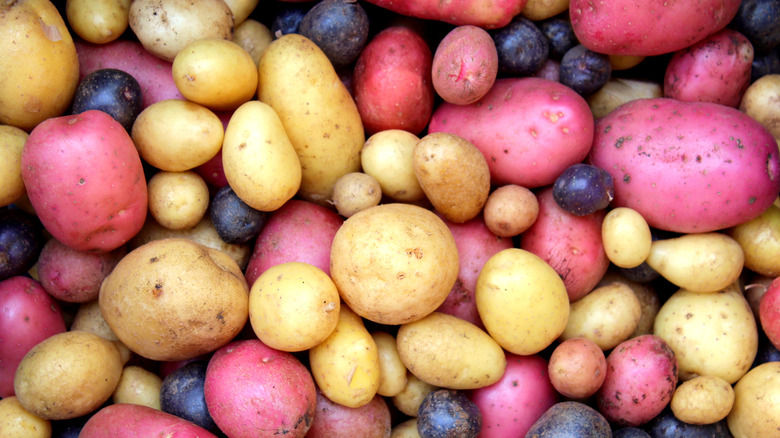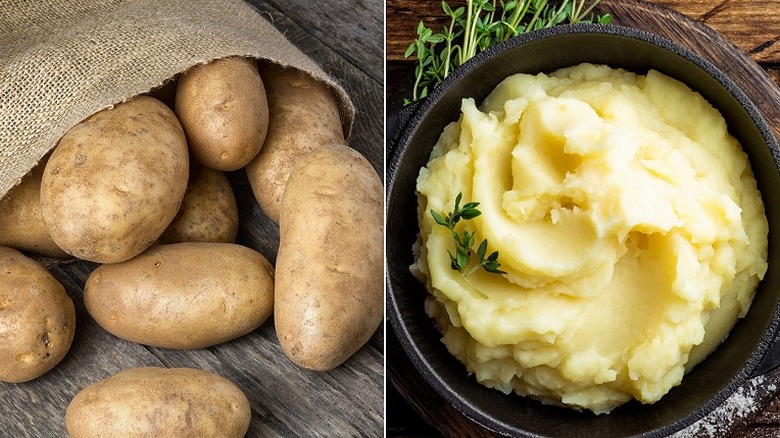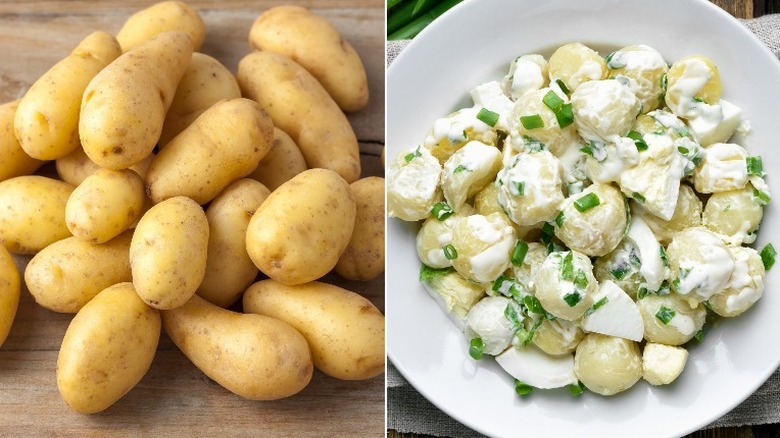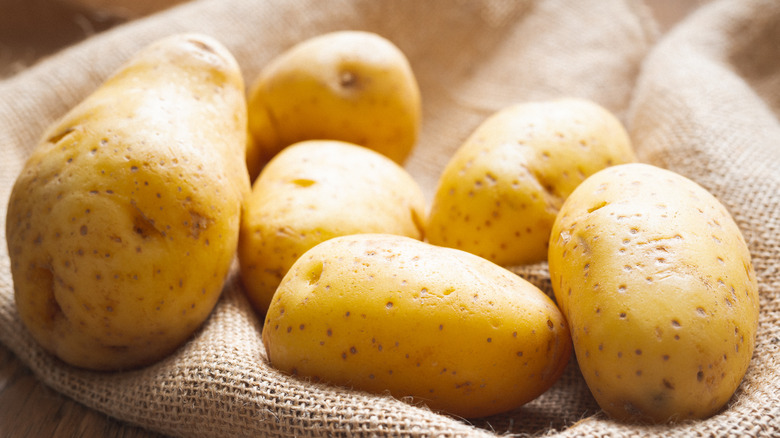Waxy Potatoes Vs Starchy Potatoes: What's The Difference?
Potatoes are such a simple, versatile ingredient, and there are so many varieties to choose from: Potatoes USA says there are over 200 types in the U.S. and hundreds more worldwide! That's both good and bad — bad because beyond the color and size, it can be hard to figure out the best kind of potato to choose for your dish. Recipes may call for "starchy" or "waxy" potatoes, but at the grocery store they're seldom labeled that way. If neither is specified and your recipe simply says "potatoes," then it's even more confusing.
The difference between the two types comes down to the way they cook, according to Martha Stewart. Starchy potatoes break down easily when cooked, and create a light, fluffy texture for dishes like mashed potatoes. In contrast, waxy potatoes hold their shape when cooked and are the better choice for dishes like potato salad and scalloped potato casseroles, where you want the potatoes to have a little bite. Once you understand this difference and learn where potatoes fall in the starchy-waxy spectrum, it's much easier to choose the perfect spud.
What are starchy potatoes?
Starchy potatoes get their name because they have a high amount of starch and low water content, according to Martha Stewart. They're very absorbent, taking in lots of the water or liquid they're cooked in, or oil, in the case of French fries and potato chips. Starchy potatoes also break apart very easily when cooked, which makes it easy to get a fluffy, flaky, and dry texture. In other words, they're ideal for mashing and frying. They also have thicker skin than waxy varieties. Jessica Gavin shares that the most familiar types of are the brown russet potatoes and Idaho potatoes. Sweet potatoes as well as yams also fall under the starchy potato umbrella.
Choose starchy potatoes for dishes like fluffy and creamy mashed potatoes; fried dishes like French fries, home fries, and potato chips; or for making homemade gnocchi. These potatoes will also be the type to use in bread doughs to make recipes like cinnamon rolls, and to puree into soups like this Creamy Potato Soup from Pinch Of Yum.
What are waxy potatoes?
Potatoes that fall in the category of waxy have a low starch content and high moisture content, Martha Stewart notes, just the opposite of starchy potatoes. Waxy potatoes have thin skins and a firm texture that tastes creamy when cooked. They will keep their shape when cooked whole, sliced, or cut into cubes and can be used in casseroles, soups, and cold salads. The waxy category includes red potatoes and smaller-sized varieties like baby potatoes, new potatoes, creamers, and fingerlings. The red-fleshed Adirondack red potatoes are also a type of waxy potato.
You can identify waxy potatoes by literally scratching their surface: The delicate skin is thin and easy to damage. Use waxy varieties in dishes where you want them to keep their shape and have some firmness in texture, like cheesy, baked au gratins, warm or cold potato salads, and brothy soups with chunks of meat or vegetables. They make great hasselback potatoes, as they have enough structure to keep the thin slits intact. Jessica Gavin says potatoes in this category are also delicious simply boiled, steamed, or roasted.
All purpose potatoes fall right in the middle
Along with starchy and waxy, there is also a group of potatoes known as all-purpose. Martha Stewart shares that these spuds have levels of starch and moisture that fall right in the middle of the other two types. This means that they can be cooked to have a fall-apart, fluffy texture like starchy potatoes or prepared to have a firmer texture like waxy kinds. White and yellow potatoes are all-purpose varieties, and this includes the gleaming Yukon gold. Purple potatoes, with deep color in both the skin and flesh are another tall-purpose type.
Bon Appétit shares that they actually prefer all-purpose Yukon golds for mashed potatoes, because the lower starch content means that, unlike russets, they're less likely to end up with a "gluey" texture. They also have a flavor that Bon Appétit describes as "buttery" — perfect for a dish that's destined to be topped with actual butter! Parade shares several ways to enjoy purple potatoes, including mashed, roasted, and even used to make latkes.
Now you can head to the potato bins at your store with confidence, knowing that you'll choose starchy types for recipes where they'll break down to make a creamy mash or tender baked potatoes. Or choose waxy potatoes for recipes where you want texture and shape. And if neither seems right, there's always all-purpose potatoes.



